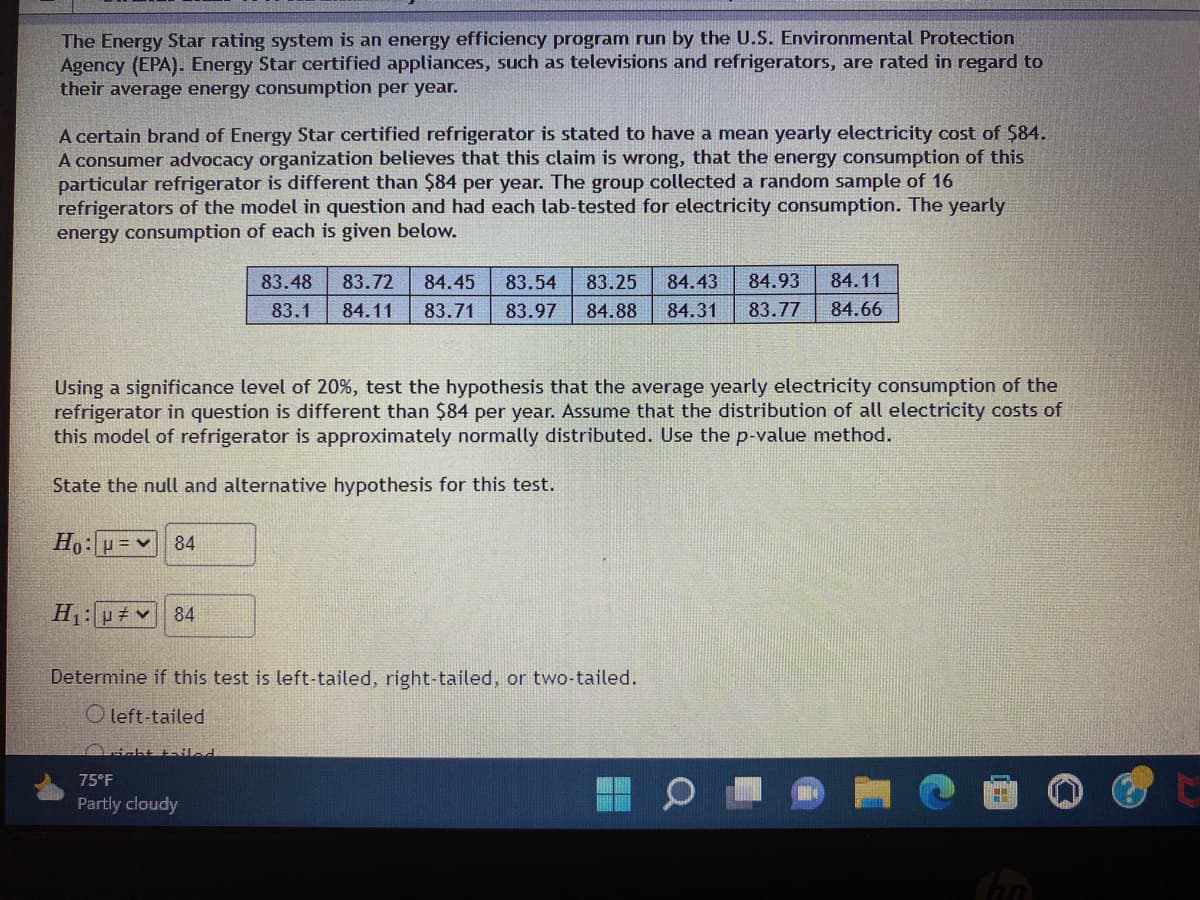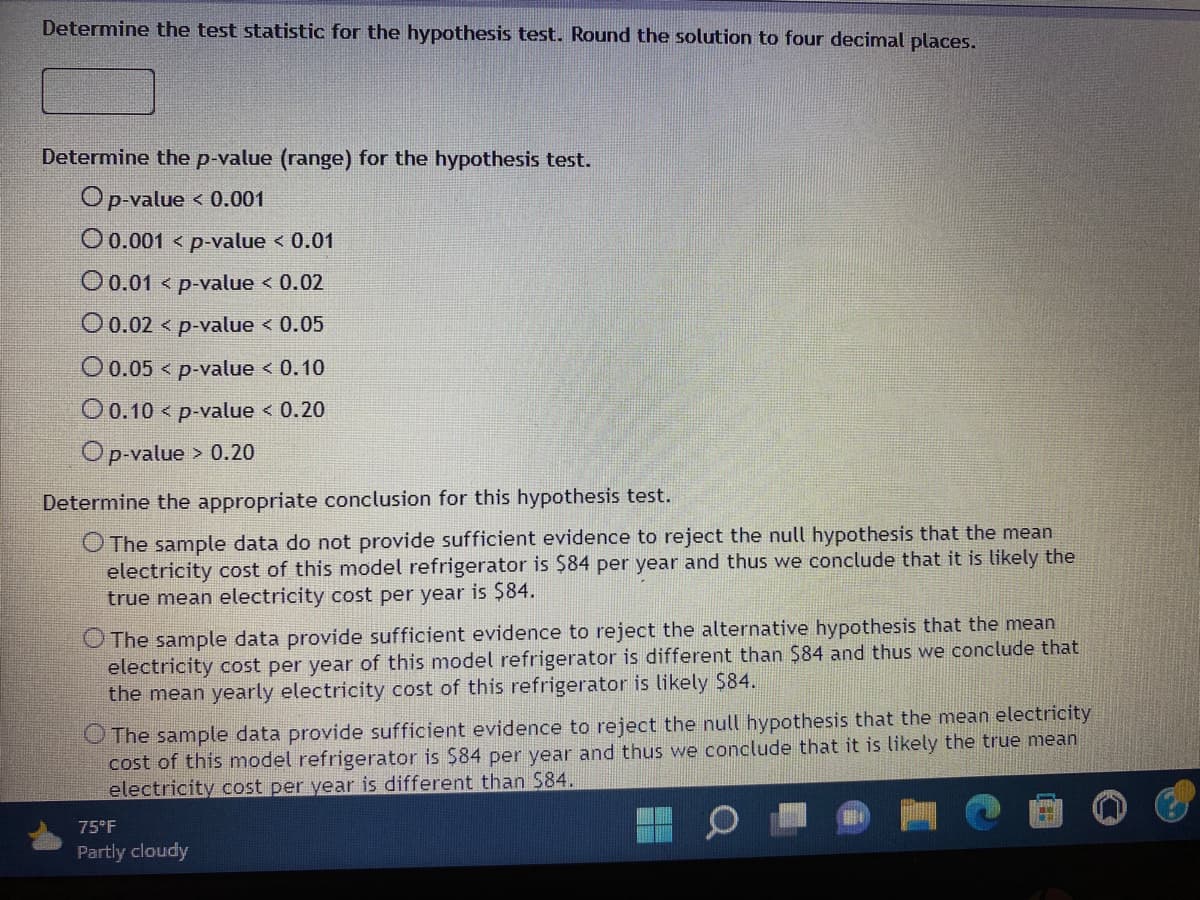The Energy Star rating system is an energy efficiency program run by the U.S. Environmental Protection Agency (EPA). Energy Star certified appliances, such as televisions and refrigerators, are rated in regard to their average energy consumption per year. A certain brand of Energy Star certified refrigerator is stated to have a mean yearly electricity cost of $84. A consumer advocacy organization believes that this claim is wrong, that the energy consumption of this particular refrigerator is different than $84 per year. The group collected a random sample of 16 refrigerators of the model in question and had each lab-tested for electricity consumption. The yearly energy consumption of each is given below. 83.48 83.1 83.72 84.45 83.54 83.25 84.43 84.93 84.11 84.11 83.71 83.97 84.88 84.31 83.77 84.66 Using a significance level of 20%, test the hypothesis that the average yearly electricity consumption of the refrigerator in question is different than $84 per year. Assume that the distribution of all electricity costs of this model of refrigerator is approximately normally distributed. Use the p-value method. State the null and alternative hypothesis for this test. Ho: P = 84 H₁:84 Determine if this test is left-tailed, right-tailed, or two-tailed. Oleft-tailed
The Energy Star rating system is an energy efficiency program run by the U.S. Environmental Protection Agency (EPA). Energy Star certified appliances, such as televisions and refrigerators, are rated in regard to their average energy consumption per year. A certain brand of Energy Star certified refrigerator is stated to have a mean yearly electricity cost of $84. A consumer advocacy organization believes that this claim is wrong, that the energy consumption of this particular refrigerator is different than $84 per year. The group collected a random sample of 16 refrigerators of the model in question and had each lab-tested for electricity consumption. The yearly energy consumption of each is given below. 83.48 83.1 83.72 84.45 83.54 83.25 84.43 84.93 84.11 84.11 83.71 83.97 84.88 84.31 83.77 84.66 Using a significance level of 20%, test the hypothesis that the average yearly electricity consumption of the refrigerator in question is different than $84 per year. Assume that the distribution of all electricity costs of this model of refrigerator is approximately normally distributed. Use the p-value method. State the null and alternative hypothesis for this test. Ho: P = 84 H₁:84 Determine if this test is left-tailed, right-tailed, or two-tailed. Oleft-tailed
Glencoe Algebra 1, Student Edition, 9780079039897, 0079039898, 2018
18th Edition
ISBN:9780079039897
Author:Carter
Publisher:Carter
Chapter10: Statistics
Section10.4: Distributions Of Data
Problem 19PFA
Related questions
Question

Transcribed Image Text:The Energy Star rating system is an energy efficiency program run by the U.S. Environmental Protection
Agency (EPA). Energy Star certified appliances, such as televisions and refrigerators, are rated in regard to
their average energy consumption per year.
A certain brand of Energy Star certified refrigerator is stated to have a mean yearly electricity cost of $84.
A consumer advocacy organization believes that this claim is wrong, that the energy consumption of this
particular refrigerator is different than $84 per year. The group collected a random sample of 16
refrigerators of the model in question and had each lab-tested for electricity consumption. The yearly
energy consumption of each is given below.
83.48
84.11
83.72 84.45 83.54 83.25 84.43 84.93
84.11 83.71 83.97 84.88 84.31 83.77
83.1
84.66
Using a significance level of 20%, test the hypothesis that the average yearly electricity consumption of the
refrigerator in question is different than $84 per year. Assume that the distribution of all electricity costs of
this model of refrigerator is approximately normally distributed. Use the p-value method.
State the null and alternative hypothesis for this test.
Ho: μ = ✓ 84
H₁: 84
Determine if this test is left-tailed, right-tailed, or two-tailed.
O left-tailed
75°F
Partly cloudy

Transcribed Image Text:Determine the test statistic for the hypothesis test. Round the solution to four decimal places.
Determine the p-value (range) for the hypothesis test.
Op-value < 0.001
O 0.001 < p-value < 0.01
O 0.01 < p-value < 0.02
O 0.02 < p-value < 0.05
O 0.05 < p-value < 0.10
O 0.10 < p-value < 0.20
Op-value >
> 0.20
Determine the appropriate conclusion for this hypothesis test.
O The sample data do not provide sufficient evidence to reject the null hypothesis that the mean
electricity cost of this model refrigerator is $84 per year and thus we conclude that it is likely the
true mean electricity cost per year is $84.
O The sample data provide sufficient evidence to reject the alternative hypothesis that the mean
electricity cost per year of this model refrigerator is different than $84 and thus we conclude that
the mean yearly electricity cost of this refrigerator is likely $84.
The sample data provide sufficient evidence to reject the null hypothesis that the mean electricity
cost of this model refrigerator is $84 per year and thus we conclude that it is likely the true mean
electricity cost per year is different than $84.
H
75°F
Partly cloudy
Expert Solution
This question has been solved!
Explore an expertly crafted, step-by-step solution for a thorough understanding of key concepts.
This is a popular solution!
Trending now
This is a popular solution!
Step by step
Solved in 5 steps

Recommended textbooks for you

Glencoe Algebra 1, Student Edition, 9780079039897…
Algebra
ISBN:
9780079039897
Author:
Carter
Publisher:
McGraw Hill

Glencoe Algebra 1, Student Edition, 9780079039897…
Algebra
ISBN:
9780079039897
Author:
Carter
Publisher:
McGraw Hill